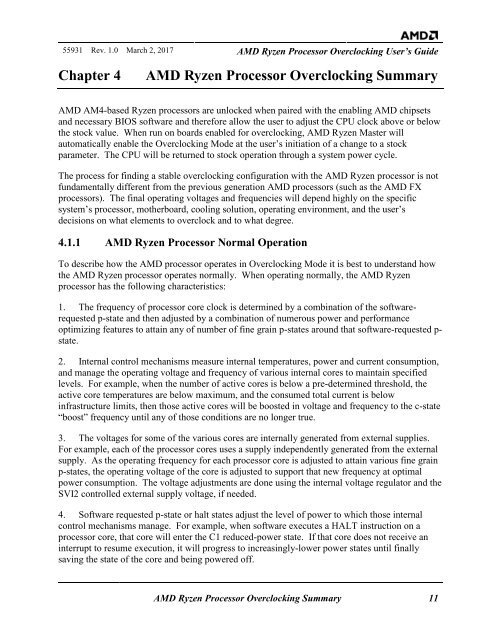AMD Ryzen Processor and AMD Ryzen Master Over-clocking User’s Guide
TwRGDa
TwRGDa
Create successful ePaper yourself
Turn your PDF publications into a flip-book with our unique Google optimized e-Paper software.
55931 Rev. 1.0 March 2, 2017 <strong>AMD</strong> <strong>Ryzen</strong> <strong>Processor</strong> <strong>Over</strong><strong>clocking</strong> <strong>User’s</strong> <strong>Guide</strong><br />
Chapter 4<br />
<strong>AMD</strong> <strong>Ryzen</strong> <strong>Processor</strong> <strong>Over</strong><strong>clocking</strong> Summary<br />
<strong>AMD</strong> AM4-based <strong>Ryzen</strong> processors are unlocked when paired with the enabling <strong>AMD</strong> chipsets<br />
<strong>and</strong> necessary BIOS software <strong>and</strong> therefore allow the user to adjust the CPU clock above or below<br />
the stock value. When run on boards enabled for over<strong>clocking</strong>, <strong>AMD</strong> <strong>Ryzen</strong> <strong>Master</strong> will<br />
automatically enable the <strong>Over</strong><strong>clocking</strong> Mode at the user’s initiation of a change to a stock<br />
parameter. The CPU will be returned to stock operation through a system power cycle.<br />
The process for finding a stable over<strong>clocking</strong> configuration with the <strong>AMD</strong> <strong>Ryzen</strong> processor is not<br />
fundamentally different from the previous generation <strong>AMD</strong> processors (such as the <strong>AMD</strong> FX<br />
processors). The final operating voltages <strong>and</strong> frequencies will depend highly on the specific<br />
system’s processor, motherboard, cooling solution, operating environment, <strong>and</strong> the user’s<br />
decisions on what elements to overclock <strong>and</strong> to what degree.<br />
4.1.1 <strong>AMD</strong> <strong>Ryzen</strong> <strong>Processor</strong> Normal Operation<br />
To describe how the <strong>AMD</strong> processor operates in <strong>Over</strong><strong>clocking</strong> Mode it is best to underst<strong>and</strong> how<br />
the <strong>AMD</strong> <strong>Ryzen</strong> processor operates normally. When operating normally, the <strong>AMD</strong> <strong>Ryzen</strong><br />
processor has the following characteristics:<br />
1. The frequency of processor core clock is determined by a combination of the softwarerequested<br />
p-state <strong>and</strong> then adjusted by a combination of numerous power <strong>and</strong> performance<br />
optimizing features to attain any of number of fine grain p-states around that software-requested p-<br />
state.<br />
2. Internal control mechanisms measure internal temperatures, power <strong>and</strong> current consumption,<br />
<strong>and</strong> manage the operating voltage <strong>and</strong> frequency of various internal cores to maintain specified<br />
levels. For example, when the number of active cores is below a pre-determined threshold, the<br />
active core temperatures are below maximum, <strong>and</strong> the consumed total current is below<br />
infrastructure limits, then those active cores will be boosted in voltage <strong>and</strong> frequency to the c-state<br />
“boost” frequency until any of those conditions are no longer true.<br />
3. The voltages for some of the various cores are internally generated from external supplies.<br />
For example, each of the processor cores uses a supply independently generated from the external<br />
supply. As the operating frequency for each processor core is adjusted to attain various fine grain<br />
p-states, the operating voltage of the core is adjusted to support that new frequency at optimal<br />
power consumption. The voltage adjustments are done using the internal voltage regulator <strong>and</strong> the<br />
SVI2 controlled external supply voltage, if needed.<br />
4. Software requested p-state or halt states adjust the level of power to which those internal<br />
control mechanisms manage. For example, when software executes a HALT instruction on a<br />
processor core, that core will enter the C1 reduced-power state. If that core does not receive an<br />
interrupt to resume execution, it will progress to increasingly-lower power states until finally<br />
saving the state of the core <strong>and</strong> being powered off.<br />
<strong>AMD</strong> <strong>Ryzen</strong> <strong>Processor</strong> <strong>Over</strong><strong>clocking</strong> Summary 11


